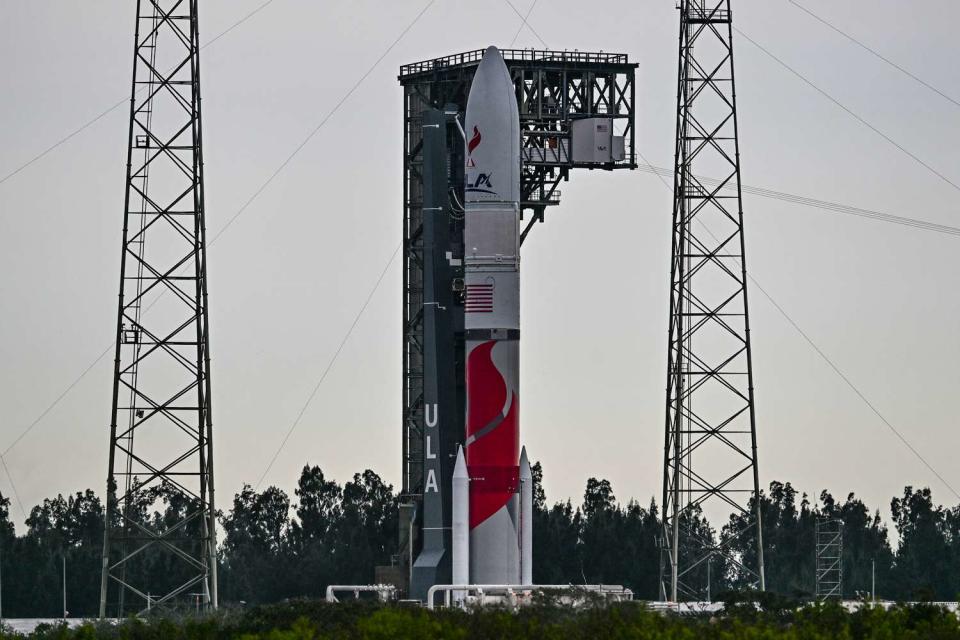A Rocket Launched Human Remains onto the Moon. Here’s Why the Navajo Nation Wanted the White House to Stop It
- Oops!Something went wrong.Please try again later.
In asking the Biden administration to intervene before the NASA-sponsored rocket ultimately took off, the Navajo Nation argued that turning a sacred celestial body into a burial site is "deeply disturbing"

CHANDAN KHANNA/AFP via Getty
NASA rocket launchThe Navajo Nation is criticizing a NASA-sponsored mission to the moon that launched early Monday with human remains on board — remains that, if all had gone according to plan, would have been deposited on the moon's surface in late February.
Peregrine Mission 1 is carrying 20 payloads on board, including some NASA instruments as well as some commercial cargo — such as human remains being transported on behalf of commercial space burial companies Elysium Space and Celestis.
Both companies advertise lunar burials for upwards of $10,000 — services that the Navajo Nation criticized the government for last week, sparking internal conversations at the White House, according to CNN's reporting.
“The moon holds a sacred place in Navajo cosmology,” Navajo Nation President Buu Nygren said in a statement issued last week. “The suggestion of transforming it into a resting place for human remains is deeply disturbing and unacceptable to our people and many other tribal nations.”
Nygren added that the launch "disregards past agreements and promises of respect and consultation between NASA and the Navajo, notably following the Lunar Prospector mission in 1998."
NASA — a federal agency led by Biden nominee Bill Nelson — is not running the launch itself, but is sponsoring the company doing so.
The placement of human remains on the moon is a profound desecration of this celestial body revered by our people. This act disregards past agreements and promises of respect and consultation between NASA and the Navajo, notably following the Lunar Prospector mission in 1998. pic.twitter.com/hhMyLEYmb4
— Navajo Nation President Buu Nygren (@BuuVanNygren) January 5, 2024
The conversations weren't enough to stall the mission, however, and in a statement issued to CNN, Celestis CEO Charles Chafer said the company rejected "the assertion that our memorial spaceflight mission desecrates the moon."
Related: First Woman and Black Male Astronaut to Make 2024 Flight Around the Moon for NASA
"Just as permanent memorials for deceased are present all over planet Earth and not considered desecration, our memorial on the moon is handled with care and reverence, is a permanent monument that does not intentionally eject flight capsules on the moon," Chafer said in the statement.
According to Celestis' website, a lunar burial starting at $12,995 "places the Celestis spacecraft carrying cremated remains or DNA on the surface of our nearest neighbor — the Moon — creating a permanent memorial on a distant, but constantly viewable world."
Elysium's website describes its service similarly, saying a lunar memorial "delivers a symbolic portion of remains to the surface of the Moon, helping to create the quintessential commemoration. Through the everlasting splendor and soft illumination of the Moon, this majestic memorial is with you and your family forever."
The rocket carrying Peregrine took off from Florida's Cape Canaveral Space Force Station at 2:18 a.m. ET Monday, with the spacecraft separating from the rocket roughly one hour later. Peregrine is now hurtling through space, en route to the moon, where it was expected to touch down on Feb. 23.
But on Monday, Astrobotic — the startup company behind the launch, which was sponsored by NASA — tweeted that a "failure" of the propulsion system had caused a "critical loss," leaving Peregrine's future uncertain.
Update #4 for Peregrine Mission One: pic.twitter.com/6uISAG3Je1
— Astrobotic (@astrobotic) January 8, 2024
The launch marked the first attempt to land on the moon from the U.S. since NASA’s final Apollo mission in 1972.
For more People news, make sure to sign up for our newsletter!
Read the original article on People.

